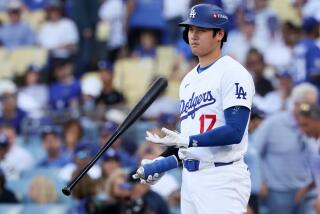Dykstra and Backman Provide the Spark : One Was Almost Traded, the Other Nearly Quit; Now They’re Key Mets By
- Share via
NEW YORK — Had it been a movie instead of a baseball game, it would have been panned by the critics. Too corny, they’d have said. No one could possibly believe such an ending.
Opening shot: Shea Stadium. The date: Saturday, Oct. 11. The principals: New York Mets and Houston Astros in Game 3 of the National League playoffs. The situation: Houston 5, New York 4, bottom of the ninth.
Cut to Wally Backman, walking toward the batter’s box to lead off. Slow pan to Dave Smith, ace Houston reliever, standing on the mound and sensing victory.
Backman takes a pitch or two, fouls off another, then drags a bunt down the first-base line and rolls head-first into the bag. The call is safe.
Tension established. Tying run aboard. Cut to Len Dykstra, all of 5-foot-10 and 160 pounds. He swipes at a Smith fastball, fouling it back.
Then, in slow motion, follow the ball as it leaves Smith’s fingers. Dykstra swings, sends it high and deep toward right field He pumps his arms in triumph as it sails over the fence.
Final score: Mets 6, Astros 5.
Unbelievable. Contrived. Pure hokum.
Believe it. Truth is stranger than fiction. The Mets know this better than most. They’ve watched all season as Backman and Dykstra, a couple of unlikely heroes, have ignited victory after victory.
“Those guys have meant so much to this club this year,” Mets catcher Gary Carter said. “Without them, there’s no way we’d be where we are. They’re spark plugs. They make things happen.”
Backman, 27, the Mets’s first pick in the June 1977 free-agent draft spent his first few seasons bouncing between New York and Tidewater, the Mets’s top farm team. He fielded well, hit some, but never to the full satisfaction of management.
At one point after he was sent down, his ferocious intensity boiled over into frustration, and he left the Tidewater team for a few days to ponder his future.
But Backman had a booster in Dave Johnson, then the manager of Tidewater. Johnson told Backman to keep the faith--that if Johnson ever got to manage the big club, Backman would have another shot.
Johnson got his chance in 1984, and so did Backman. He’s been in New York since.
“Wally is great at getting on base,” said Johnson, now in his third year as Mets manager. “He plays that role very well, and his intensity is just great.”
Although a switch-hitter, Backman played mostly against right-handed pitching this season, and along with Dykstra set the table at the top of the batting order for the power hitters.
While playing solid defense, Backman batted .320 in 124 games. More important for the Mets, however, was his consistency. He struck out just 47 times, meaning he was a particularly adept contact hitter who could advance runners.
Dykstra, 23, came to the Mets in the June 1981 free-agent draft, their 12th selection. His first full season in the majors was 1985 when he batted .254 in 83 games as an emergency replacement for the injured Mookie Wilson. He played so well, however, he displaced Wilson as the regular center fielder and leadoff man.
More to Read
Go beyond the scoreboard
Get the latest on L.A.'s teams in the daily Sports Report newsletter.
You may occasionally receive promotional content from the Los Angeles Times.










